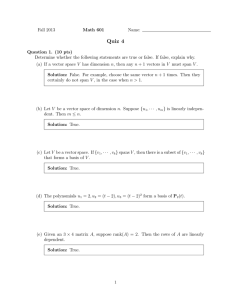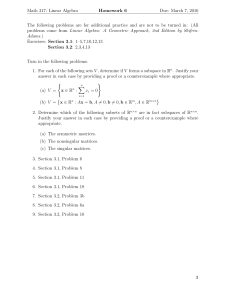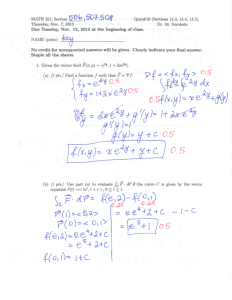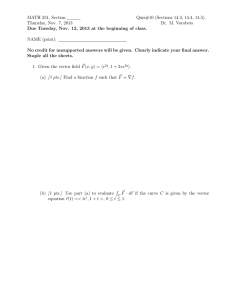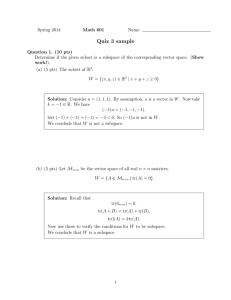Practice Final Exam
advertisement
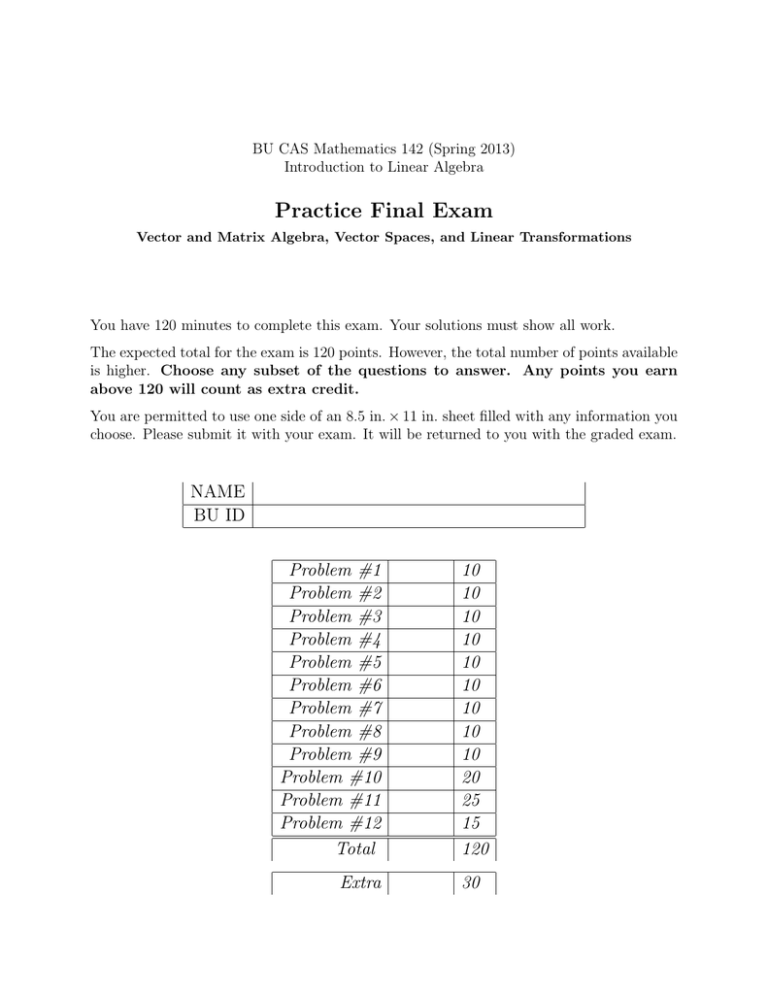
BU CAS Mathematics 142 (Spring 2013)
Introduction to Linear Algebra
Practice Final Exam
Vector and Matrix Algebra, Vector Spaces, and Linear Transformations
You have 120 minutes to complete this exam. Your solutions must show all work.
The expected total for the exam is 120 points. However, the total number of points available
is higher. Choose any subset of the questions to answer. Any points you earn
above 120 will count as extra credit.
You are permitted to use one side of an 8.5 in. × 11 in. sheet filled with any information you
choose. Please submit it with your exam. It will be returned to you with the graded exam.
NAME
BU ID
Problem #1
Problem #2
Problem #3
Problem #4
Problem #5
Problem #6
Problem #7
Problem #8
Problem #9
Problem #10
Problem #11
Problem #12
Total
Extra
10
10
10
10
10
10
10
10
10
20
25
15
120
30
Problem 1. (10 pts.)
Solve the following equation for x, y ∈ R.
2 4
x
−2
=
1 3
y
1
The matrix is invertible, so there is a unique solution
2 4
1 3
−1 −2
1
=
−5
.
2
Problem 2. (10 pts.)
Determine whether each of the following sets of matrices is closed under matrix multiplication
(you may assume these are all subsets of Rn×n ). If it is closed, justify your answer; if it is
not, provide a counterexample (e.g., in R2×2 ).
(a) {M | M is upper triangular and M is invertible}
Both the set of upper triangular matrices and the set of invertible matrices are closed
under matrix multiplication. Thus, two matrices A and B are both upper triangular
and invertible, then A · B must be triangular, and it must be invertible. Thus, the set
is closed under matrix multiplication.
(b) {M | M is upper triangular or M is diagonal}
For any two matrices A and B in the set, we have the following possibilities:
• if both matrices are diagonal, A · B is diagonal;
• if both matrices are upper triangular, A · B is upper triangular;
• if one matrix is diagonal and the other is upper triangular, then A · B is upper
triangular because all diagonal matrices are by definition upper triangular;
In other words, this set is equivalent to the set of upper triangular matrices because all
diagonal matrices are upper triangular. We know the set of upper triangular matrices
is closed under multiplication.
(c) {M | M has no zero entries}
We know that a matrix with orthogonal columns and no zero entries will yield a matrix
with zero entries when multiplied by its own transpose, so this set cannot be closed.
Here is one such counterexample:
1 2
−1 2
> 1 2
2 0
·
=
−1 2
0 8
Problem 3. (10 pts.)
Assume that a, b ∈ R, a 6= 0,
26
1
14 = 0
39
0
b 6= 0, and that
0 0
2 4
1 0 0 3
0 1
1 6
Compute the following to obtain an
2
0
1
the following equation is true:
1
a
b2 2
1/a
2 −9a 2b2 3 4/b2
5
0
0 4
1
explicit vector in R2 :
−1
4 1
26
3 2 14 = ?
6 5
39
We expand the left-hand side of the second equation using the first equation, then cancel
terms, then multiply:
−1
−1
1 0 0
2 4 1
a
b2 2
1/a
26
2 4 1
2 4 1
0 3 2 14 = 0 3 2 0 1 0 0 3 2 −9a 2b2 3 4/b2
0 0 1
1 6 5
0
0 4
1
39
1 6 5
1 6 5
−1
2 4 1
2 4 1
a
b2 2
1/a
2
0 3 2
0 3 2
−9a 2b 3
4/b2
=
1 6 5
1 6 5
0
0 4
1
2
a
b 2
1/a
2
−9a 2b 3
4/b2
=
1
0
0 4
1+4+2
−9 + 2 + 3
=
4
7
= −4
4
Problem 4. (10 pts.)
Consider the following linear transformations f, g, h ∈ R2 → R2 (i.e., the domain is always
R2 and the codomain is always R2 ):
f (v) =
−2 1
8 −4
·v
g(v) =
4 1
8 2
·v
h(v) =
1 −2
7 5
·v
(a) Define im(f ) as a span of one or more vectors and find its basis and dimension.
We have that:
n 1 o
im(f ) = span
.
−4
Since the space is the span of a single vector, one possible smallest basis is:
n 1 o
.
−4
Its dimension is the size of any basis, so:
n
1 o
dim(im(f )) = = 1.
−4
(b) Either prove that g is surjective or provide a counterexample.
The linear transformation g is not surjective. Since the two columns of the matrix used
to define g are linearly dependent, any w not on the line spanned by the two columns
could not be an output of g; for example:
1
g(v) =
0
4·x+1·y = 1
8 · x + 2 · y = 2 according to the first row equation
8 · x + 2 · y = 0 according to the second row equation
(c) Either prove that h is injective or provide a counterexample.
The matrix is invertible, so h is bijective, which means it is both surjective and injective.
To show that it is injective, let the matrix be M . Then we have for any v, v 0 ∈ R2 :
f (v)
M ·v
−1
M ·M ·v
v
=
=
=
=
f (v 0 )
M · v0
M −1 · M · v 0
v0
Problem 5. (10 pts.)
You are given the following data points:
−1
1
0
1
,
,
.
4
1
Find a polynomial of the form f (x) = ax + b that is the least squares best fit for this data.
We first set up the matrix equation for fitting a curve to some points:
−1 1
1
0 1 · a
= 4
b
1 1
1
The above equation (call it M · v = w has no solution. Thus, we find an orthonormal basis
of the span of the columns of the matrix, project the vector on the right-hand side onto that
span to obtain w∗ , and create a new, solvable equation M · v ∗ = w∗ . The solution v ∗ to that
equation is the least-squares approximate solution with error ||w − w∗ ||.
The two columns vectors are already orthogonal (their dot product is 0), so it is sufficient
to normalize them in order to create an orthonormal basis:
√−1 1
√
(2)
n
o
√13
span 0 , 3
√1
√1
(2)
3
We perform the projection to obtain the new equation:
√1
√−1 √−1
1
(2)
(2)
1
3
∗
4 · 0 · 0 + 4 · √13 ·
w =
√1
√1
√1
1
1
3
(2)
(2)
√1
3
√1
3
√1
3
= 0+
6
3
6
3
6
3
2
= 2
2
We can now build the new solvable equation and find its solution:
−1 1
2
0 1 · a
2
=
b
1 1
2
a
0
=
b
2
Thus, the polynomial that is the least-squares best fit for this data is f (x) = 0 · x + 2 or just
f (x) = 2.
Problem 6. (10 pts.)
Use the Gram-Schmidt process to find an orthonormal basis of the following vector space
(you must use the Gram-Schmidt process to receive full credit):
−1
1
−3
n 0 1 1 o
V = span
0 , 1 , 1
0
2
2
What is the dimension of the space?
First, we remove one vector from the spanning set of vectors because it is a linear combination
of the other two:
1
−1
−3
1
+4· 0 = 1
1
0
1
2
0
2
The set is now a basis of the form {v1 , v2 }. We need to make it an orthonormal basis {e1 , e2 }
using the Gram-Schmidt process for two steps. We first find e1 :
−1
0
1
· u1 = u1 = v1 =
e1 =
0
1
0
Next, we find e2 :
v2
u2
1
1
=
1
2
1
1
=
1 −
2
e2 =
1
· u2
||u2 ||
−1
1
−1
0 0
1
·
·
1 0 0
0
2
0
0
0
1
√
1 1
6
=
= √ ·
√1
1
6
6
√2
2
6
1
1
1 0
= −
1 0
2
0
0
= 1
1
2
Problem 7. (10 pts.)
Let f : R2 → R be defined as:
f (v) = ||v||.
Show that f is not a linear transformation (i.e., find a counterexample).
It is sufficient to find a counterexample that contradicts one of the two properties of a linear
transformation. For example:
−1 f
= 1
0
1 f
= 1
0
1 −1 0 f
+
= f
0
0
0
= 0
0 6= 2
1 0 1 0 f
6= f
+f
+
0
1
0
1
Problem 8. (10 pts.)
A function f (x) = ax3 + bx2 + cx + d has slope 4 at x = 0 and intersects the following points:
0
1
−1
2
,
,
.
−4
29
Set up an appropriate matrix equation to find the coefficients of f and solve it.
We know that the derivative of f is f 0 (x) = 3ax2 + 2bx + c. Thus, if the slope of f is 4 at
x = 0, this means:
f 0 (0) = 4.
We can set up the following matrix equation to solve for the coefficients a, b, c, and d ∈ R:
(−1)3 (−1)2 (−1) 1
a
−4
(0)3
(0)2
(0) 1
· b = 1
2
(2)3
(2)
(2) 1
c
29
3(0)2 2(0)
1
0
d
4
Problem 9. (10 pts.)
n a b o
Let
,
be an orthonormal basis. If a =
c
d
We know that the following are true:
a
·
c
a
c
b
d
√
3
2
b
= 0
d
= 1
= 1
Thus, we have:
ab + cd = 0
a2 + c 2 = 1
b 2 + d2 = 1
This implies that:
c = 1−
√3 2
2
1
= ±
2
Since we must have c + d > 0, we let c = 12 , so:
√
3
1
b+ d = 0
2
2
1
2
√
3
d = ±
2
b = ±
√
Since we want c + d > 0, we let d =
3
2
√
and b = −
3
.
2
√
and c + d >
3−1
,
2
find b, c, and d.
Problem 10. (20 pts.)
You are given the following data points:
−1
2
0
1
,
,
.
1
3
Find a polynomial of the form f (x) = ax + b that is the least squares best fit for this data.
Hint: use the formula for computing a projection onto the image of a matrix.
We are looking for an approximate solution to the overdetermined system:
−1 1 2
0 1 a = 1 .
b
1 1
3
2
We project 1 onto the image of the matrix above:
3
>
>
−1 1
−1 1 −1
−1 1
2
3/2
−1 1
0 1 · 0 1 0 1
· 0 1 1 = 2 .
1 1
1 1
1 1
1 1
3
5/2
2
3/2
Now, if we replace 1 with its projection 2 , the system is no longer overdeter3
5/2
mined:
−1 1 3/2
0 1 a = 2 .
b
1 1
5/2
The approximate solution is then:
1
f (x) = x + 2.
2
Problem 11. (25 pts.)
Consider the following vector subspaces of R3 :
n 1 o
n −4 o
V = span 0
W = span 1
−2
2
20
You are in a spaceship positioned at 15 and a signal transmitter is positioned at
−30
0
0 .
0
(a) Suppose the transmitter’s signal beam only travels in two opposite directions along V .
What is the shortest distance your spaceship must travel to intercept the signal beam?
The closest interception point is the projection of the ship’s position onto V . First, we
find the unit vector that spans V :
1
√
5
u = 0 .
−2
√
5
Next, we project the spaceship’s position onto spanu using the formula (u · v) · u:
√1
5
1
√
20
16
5
p = ( 0 · 15 ) · 0 = 0 .
−2
−2
√
√
−30
−32
5
5
Finally, the distance is
20
16
4 √
√
15 − 0 = 15 = 245 = 7 5
−30
−32
2
(b) Suppose the transmitter is also rotating around the axis collinear with W . What is
the shortest distance your spaceship must travel to reach a position at which it can
intercept the signal beam?
Because the transmitter is rotating, the beam sweeps around and covers a plane that
is perpendicular to the axis of rotation. The closest
point is the projection
interception
1
of the ship’s position onto W ⊥ . We have that 0 is orthogonal to W . We find
−2
1
another vector orthogonal to W and 0 :
−2
−4x + y + 2z = 0
x − 2z = 0
1
x
z =
2
y = 3x
Let x = 2. Thus, we want to project the spaceship’s position onto the image of:
1 2
M = 0 6 .
−2 1
The projection is then:
p =
=
=
As in part (a), the distance
20
M · (M > · M )−1 · M > · 15
−30
20
1
41 0
·
· M > · 15
M·
0 5
205
−30
4280
1
3000
·
205
−6060
20
4280
−0.9
1
is 15 − 205
· 3000 ≈ 0.4 .
−30
−6060
−0.4
Problem 12. (15 pts.)
Let vectors xy ∈ R2 be system state descriptions that represent population quantities in
two locations (e.g., x is the number of people in the city and y is the number of people in
the suburbs). Let f represent a change in the quantities over the course of one year if the
economy is doing well, and let g represents a change in the quantities over the course of one
year if the economy is not doing well:
60 120
0.06 0.12
f (v) =
·v
g(v) =
·v
20 40
0.02 0.04
If the initial state is v0 = 31 and after 100 years the state is 300000
, during how many
100000
years of this period was the economy doing well?
We first determine the eigenvalue of v0 for both matrices:
60 120
3
300
3
·
=
= 100 ·
20 40
1
100
1
0.06 0.12
3
0.3
3
·
=
= 0.1 ·
0.02 0.04
1
0.1
1
, the following equations repThus, if the economy after 100 years is in the state 300000
100000
resents this constraint (we do not care about the order because multiplication of scalars is
commutative, and we have replaced all matrices in the term with scalars):
3
300000
n
m
100 · 0.1 ·
=
1
100000
n + m = 100
The first equation can be simplified:
2n
10
−m
· 10
·
3
1
5
= 10 ·
3
1
102n · 10−m = 105
2n − m = 5
Given two equations with two unknowns, we can now solve for n and m:
2n − (100 − n)
3n
n
m
=
=
=
=
5
105
35
65
Thus, there were 35 years of a good economy and 65 years of a poor economy (in some
order).



